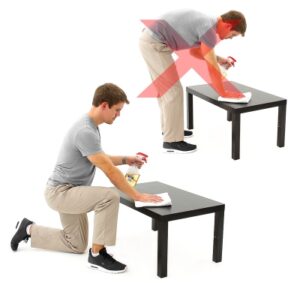We are all pros at something, but for the vast majority of us, it isn’t cycling. If you are like me, it isn’t home or yard do-it-yourself projects either. That is why it is important practice proper body mechanics during the performance of household and vocational tasks.
Having the strongest core and legs doesn’t mean a thing if you don’t use them properly. And if you don’t use them properly, you risk saddle time spent on the couch with a sore back!
Below you will find some tips to help protect your spine and joints. Add them to your database of things you should be doing, even if it takes a bit of EXTRA effort and thought to do so.

KNEE HEIGHT LIFTING
Start by standing close to the object with feet spread apart. Bend at the knees and hips and NOT at your spine. Hold the object close to your body as you use your legs to stand back up while lifting the object. Walk over to the surface you want to set the object onto and set it down bending at the knees slightly.
Do not bend at the spine. Also, be sure NOT to twist your spine, but to pivot your feet so that your feet are pointed forward to where you want to set the object.
Slide the object on the shelf to off load your body.

WAIST HEIGHT LIFTING
Start by standing close to the object with feet spread apart. Bend at the knees and hips and NOT at your spine. Hold the object close to your body as you use your legs to stand back up while lifting the object. Walk over to the surface you want to set the object onto and set it down.
Be sure to NOT twist your spine, but to pivot your feet so that your feet are pointed forward to where you want to set the object. Slide the object on the shelf to offload your body.

OVERHEAD LIFTING
Start by standing close to the object with feet spread apart. Bend at the knees and hips and NOT at your spine. Hold the object close to your body as you use your legs to stand back up while lifting the object. Walk over to the surface you want to set the object onto and raise it up overhead with a “one-hand-under and one-hand-over” technique as shown.
Set it down and DO NOT extend at the spine. Also, be sure NOT to twist your spine but to pivot your feet so that your feet are pointed forward to where you want to set the object. Slide the object on the shelf to offload your body.

CLEANING LOW SURFACES
When cleaning a low surface such as a table, position yourself into a half-kneel position as shown. You should have one knee on the ground and the other knee bent with your foot on the ground.
Keep your spine straight. Place a pillow or folder towel under your down-knee if needed for comfort.

CARRYING A BAG OR SUITCASE
When carrying bags, be sure to distribute the weight evenly between the right and left side of your body. Maintain a straight spine. If you are carrying only one bag then switch sides periodically.

RAKING
When raking keep your arms close to the center of your body and do not bend over at the spine. Bend your knees and lunge if needed. Keep your spine straight.

MOWING THE LAWN
When mowing the lawn, walk with the mower to minimize bending over. Also, extend the handle, if adjustable, to improve reach. Keep your spine straight.

DIGGING WITH A SHOVEL
When digging with a shovel, keep the shovel tip close to your body and keep your spine straight.

USING A SCOOP SHOVEL
When scooping with a shovel, move in a lunge pattern with one foot in front of the other as you bend your knees to move forward and back. Keep your spine straight.
The Follow-Up Appointment
Stay tuned, as in the next edition of this series I will introduce the theory of periodization for off-the-bike strength training and why it is important to your performance on the bike.
Your Call!
Do you have any physical therapy related topics or questions which haven’t been addressed that you feel would improve your cycling performance and enjoyment? Let me know!


